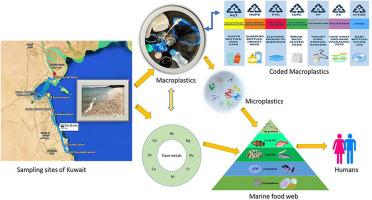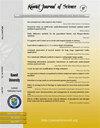Impact of hydrophobic additives in macroplastics and trace metal contamination on Kuwait's coastal beaches
IF 1.1
4区 综合性期刊
Q3 MULTIDISCIPLINARY SCIENCES
引用次数: 0
Abstract
The global rise in macroplastic waste has adversely affected Kuwait's beaches, presenting potential threats to the marine ecosystem. In this study, debris samples were collected and analyzed from eleven beach sites between 2022 and 2024. Macroplastics distributed across the studied sites were more abundant in the winter (76 %) than in the summer (59 %) seasons. The polypropylene items were highly apportioned (25 %) among the seven identified polymers in this study. Among the sites, macroplastics recovered from the S3 (intertidal mudflats, fishing, wastewater drains), S4 (recreation), and S9 (industries) areas showed high mean concentrations of Cr (512.62 μg/kg), Ni (248.49 μg/kg), and Zn (36.04 μg/kg) compared to the other analyzed metals. The indices outlined in this study reflected the characteristics of occupational activities, the negligence of beachgoers towards pollution, the presence of seven macroplastics types, impact of additive pollutants, and were corroborated by assessments of clean coastal (CCI), polymer abundance (PAI), and polymer hazardous (PHI) indices. Furthermore, observations showed that hydrological factors and seasonal variations influenced the abundance of macroplastics, validating macroplastics as a beach pollutant indicator. Conjecturing the apportionment and futuristic escalation of macroplastics pollution threats, this study depicts the salient mitigation strategies to decrease macroplastics in the marine environment.

宏观塑料中的疏水添加剂和微量金属污染对科威特沿海海滩的影响
全球宏观塑料垃圾的增加对科威特的海滩产生了不利影响,对海洋生态系统构成了潜在威胁。在这项研究中,研究人员在2022年至2024年间从11个海滩收集并分析了碎片样本。分布在研究地点的宏观塑料在冬季(76%)比夏季(59%)更为丰富。在本研究中,聚丙烯项目在七种已确定的聚合物中比例很高(25%)。其中,S3(潮间带滩涂、渔场、污水排放口)、S4(娱乐场所)和S9(工业)区回收的宏观塑料中Cr (512.62 μg/kg)、Ni (248.49 μg/kg)和Zn (36.04 μg/kg)的平均浓度高于其他重金属。本研究概述的指数反映了职业活动的特征、海滩游客对污染的忽视、七种宏观塑料的存在、添加剂污染物的影响,并通过清洁海岸(CCI)、聚合物丰度(PAI)和聚合物危险(PHI)指数的评估得到了证实。此外,观测结果表明,水文因素和季节变化影响了巨塑性塑料的丰度,验证了巨塑性塑料作为海滩污染物指标的有效性。本研究推测了宏观塑料污染威胁的分配和未来的升级,描述了减少海洋环境中宏观塑料的显著缓解策略。
本文章由计算机程序翻译,如有差异,请以英文原文为准。
求助全文
约1分钟内获得全文
求助全文
来源期刊

Kuwait Journal of Science
MULTIDISCIPLINARY SCIENCES-
CiteScore
1.60
自引率
28.60%
发文量
132
期刊介绍:
Kuwait Journal of Science (KJS) is indexed and abstracted by major publishing houses such as Chemical Abstract, Science Citation Index, Current contents, Mathematics Abstract, Micribiological Abstracts etc. KJS publishes peer-review articles in various fields of Science including Mathematics, Computer Science, Physics, Statistics, Biology, Chemistry and Earth & Environmental Sciences. In addition, it also aims to bring the results of scientific research carried out under a variety of intellectual traditions and organizations to the attention of specialized scholarly readership. As such, the publisher expects the submission of original manuscripts which contain analysis and solutions about important theoretical, empirical and normative issues.
 求助内容:
求助内容: 应助结果提醒方式:
应助结果提醒方式:


